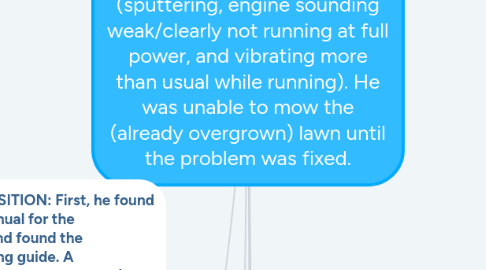PROBLEM STATEMENT: As Anthony Chavez (my husband) was trying to mow the lawn, the lawnmower was stalling and had a rough idle (sputtering, engine sounding weak/clearly not running at full power, and vibrating more than usual while running). He was unable to mow the (already overgrown) lawn until the problem was fixed.
by Alexandra Chavez

1. DECOMPOSITION: First, he found the online manual for the lawnmower and found the troubleshooting guide. A lawnmower has many parts such as the engine, handlebar, pull cord, wheels, gas tank, the blades, and the base. The engine itself is also comprised of many parts such as the carburetor, crank case, exhaust system, ignition, air filtration system, etc.
1.1. RATIONALE: Decomposition is "breaking down data, processes, or problems into smaller, manageable parts" ("Computational Thinking for Educators," n.d.). A lawnmower has many parts. If a specific part(s) is/are broken they will present this in different ways.
2. PATTERN RECOGNITION: We can eliminate certain parts as possible causes of the problem. For example, "things like the wheels, handlebar, gas cap, pull cord, or oil would not affect the engine stalling" (Chavez, 2019). Most of these are intuitive even to someone like me who is not very knowledgeable about such machines. This only leaves parts of the engine as possible causes of the problem. Most small gas-powered engines have some kind of ignition system (which includes a spark plug, wire, and coil), a carburetor, fuel system, an air filtration system, and an alternator. Anthony said he likes to "try and repair the easiest and/or cheapest possible cause(s) first" (Chavez, 2019).
2.1. RATIONALE: Pattern Recognition is "observing patterns, trends, and regularities in data,"("Computational Thinking for Educators," n.d.). Any gas-powered small engine has similar parts that make it run. Through experience and/or a troubleshooting manual for the lawnmower, many parts can be eliminated as possible causes, narrowing down the parts that can cause the malfunction (Chavez, 2019).
3. ABSTRACTION: Anthony realized from past experience that there are only so many parts that can cause an engine to stall or have a rough idle. These parts can be cleaned and/or replaced one by one to see if the problem is fixed. If not, then move on to the next part. He can use this knowledge when working on other small gas-powered engines, even if lacking a manual.
3.1. RATIONALE: Abstraction is "identifying the general principles that generate these patterns," ("Computational Thinking for Educators," n.d.). As most gas-powered engines apply the same mechanics to make them run, this knowledge of how they work (and what can cause issues like stalling/rough idle) can be applied to other similar machines with gas-powered engines.
4. ALGORITHM DESIGN: Anthony wrote down the list of parts that could possibly be causing the lawnmower to stall and have a rough idle. These parts included the air filter, carburetor, and spark plug. He went to Home Depot to buy the items, keeping the receipt in case any parts proved to be unnecessary. The easiest thing to fix was the air filter (which he saw was indeed dirty). So it was replaced but did not fix the problem when he tested the lawnmower. Next he removed the carburetor, took it apart and cleaned all the individual parts of it (which were covered in dirt and grass, a jet was clogged up, and the fuel bowl/inside were also dirty). This time the lawnmower was running but was now misfiring. He then checked the spark plug (the ends looked burnt) and replaced it. The lawnmower now runs perfectly.
4.1. RATIONALE: An algorithm is Developing the step by step instructions for solving this and similar problems" ("Computational Thinking for Educators," n.d.). These are the steps Anthony took using both his experience and the manual to fix the problem. These steps can be taken to solve other similar gas-powered engine issues.
5. REFERENCES: Computational Thinking for Educators. (n.d.). Retrieved June 28, 2019, from https://computationalthinkingcourse.withgoogle.com/unit. Chavez, A. (2019, June 27). Personal Interview.



